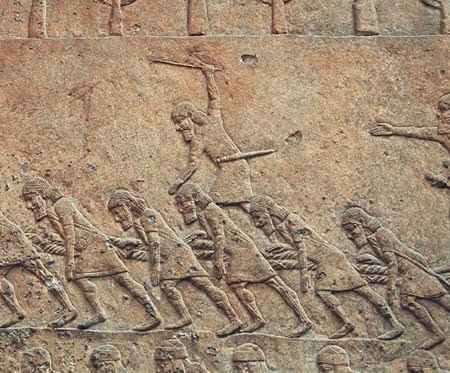How the Powerful Assyrian Empire Captured the Northern Kingdom of Israel
In the intricate history of ancient Middle Eastern civilizations, few empires matched the Assyrians in strength and brutality. Their military prowess and harsh strategies led to the domination of many peoples, including the Israelites from the Northern Kingdom of Israel.

The Rise of the Assyrian Empire
The Assyrian Empire, which began in the city of Assur in what is now northern Iraq, aggressively expanded during the 1st millennium BCE. By the 8th century BCE, under prominent rulers like Tiglath-Pileser III and Shalmaneser V, the empire had reached its greatest extent, stretching from present-day Iran to Egypt.

The Fall of the Northern Kingdom
The Northern Kingdom of Israel, with Samaria as its capital, first became a vassal state under Tiglath-Pileser III when King Menahem paid a substantial tribute to avoid invasion. However, subsequent kings, such as Pekah, sought to rebel and create alliances to resist Assyrian dominance. This resistance resulted in severe repercussions, as Shalmaneser V laid siege to Samaria for three years before Sargon II captured it in 722 BCE, signaling the end of the Northern Kingdom.
Deportation and Assyrian Policy
The Assyrians enforced a harsh policy of mass deportation. After the fall of Samaria, Sargon II relocated a large segment of the Israelite population, with estimates indicating around 27,000 were moved throughout the Assyrian Empire. This approach intended to thwart future uprisings and integrate the conquered peoples into Assyrian culture, leading to the scattering of the ten northern tribes, who would later be referred to as the “Lost Tribes of Israel.”

Legacy and Implications
The Assyrian conquest left enduring impacts on the Hebrew people:
Cultural and Religious Transformation
In exile, the Israelites encountered different cultures, resulting in an exchange of ideas and beliefs. While many maintained their unique identities, some adapted to Assyrian society.
The Rise of the Southern Kingdom
With the Northern Kingdom destroyed, the Southern Kingdom of Judah, centered in Jerusalem, became the main Hebrew state. This geopolitical change heightened the centralization of religious practices around the Temple in Jerusalem.
Historical and Biblical Importance
The Assyrian exile is mentioned in biblical scriptures, including the Books of Kings and Chronicles. Prophets such as Hosea and Isaiah viewed the exile as divine retribution for Israel’s wrongdoings.

Historical Context of Deportation
Although the Assyrian deportation is one of the most significant examples of Hebrew displacement, it was not unprecedented. Previous encounters with empires like Egypt resulted in the Israelites’ enslavement, as described in the Book of Exodus. Nonetheless, the Assyrian deportation is notable for its magnitude and lasting cultural effects, leading to the widespread dispersal of ten of Israel’s twelve tribes.

The Assyrian subjugation of the Israelites stands as a profound reminder of the turbulent histories that shaped ancient Middle Eastern civilizations. Even though the Northern Kingdom of Israel came to an end, its cultural and religious legacy persisted, significantly influencing ancient Semitic traditions and beliefs.

